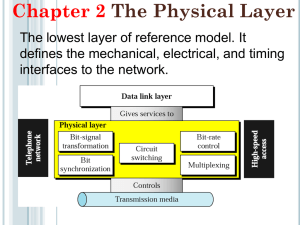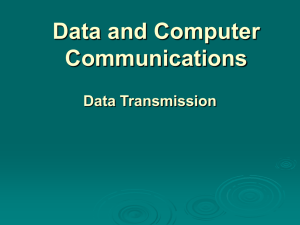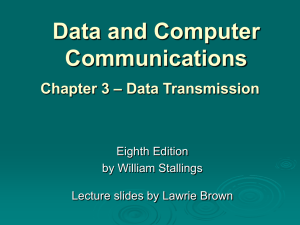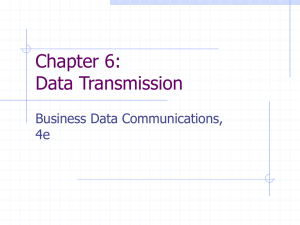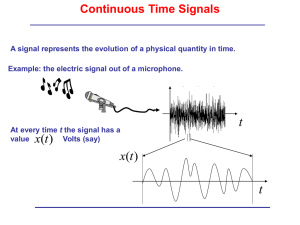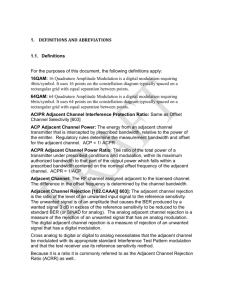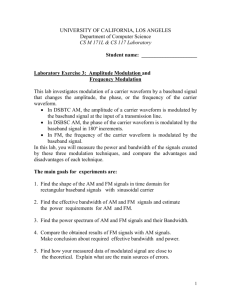Chapter one - Introduction
advertisement
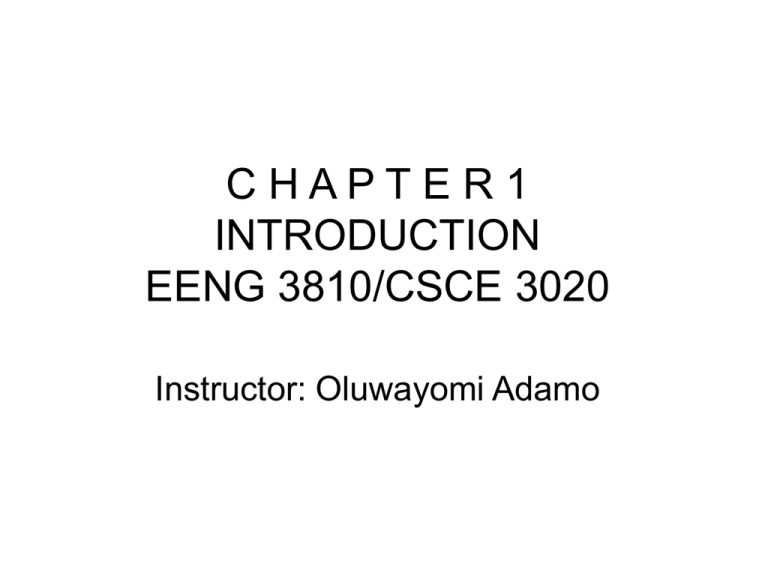
CHAPTER1 INTRODUCTION EENG 3810/CSCE 3020 Instructor: Oluwayomi Adamo Introduction • Basic principles of communication by electric signals will be studied • Messages were carried by runners, carrier pigeons, lights and fires in the past • Many of these methods were limited by distance and data rates – replaced by electrical communication system. • Electrical communication is dependable and economical • The course is also aimed at providing the technical knowledge needed for designing better communication systems. Communications • Communications is the Process of Transmitting Information from a Source to a Destination Source Destination • Example of typical communication systems – Wire-line telephone – Cellular phone connection – TV broadcasting system – Wireless computer network Figure 1.1 Some examples of communications systems. Communication System Model Figure 1.2 Communication system Model Communication System Model (cntd) • Source: originates a message (human voice, a television picture, an email, or data message, or data • Input Transducer: Converts nonelectric (human voice, email text, TV video) into an electric waveform called a message or baseband signal using physical devices (microphone, a computer keyboard, or a CCD camera • Transmitter: Modifies the baseband signal for efficient transmission and may consist of A/D converter, an encoder, and a modulator. Receiver- Demodulator, decoder and D/A. • Channel: Medium that convey the electric signals at the transmitter output over a distance e.g twisted copper wire – telephone and DSL, Coaxial Cable – television and internet, optical fiber or radio link Communication Systems Model • Receiver: Reprocesses signals received from the channel by reversing signal modifications made at the transmitter. Removal of noise due to channel. • Output Transducer: Converts electric signal to its original form (Message) • Destination: Unit to which message is communicated. • Channel behaves like a filter by attenuating the signal (vary with channel length) and distorts the transmitted waveforms. • Signal waveform Distortion – due to physical phenomena such as frequency-dependent gains, multipath effects and Doppler shifts. Noise • Undesirable interferences and disturbances that corrupts signal passing through communication channel (different from channel distortion) • Random, and unpredictable. • External noise: Interference signals transmitted on nearby channels, human-made noise generated from faulty contact switches of electrical equipment, automobile ignition radiation, lightening, and cell phones emission. • Internal noise: results from thermal motion of charged particles in conductors, random emission, and diffusion or recombination of charged carriers in electronic devices • Noise limits the rate of telecommunications. Noise • The channel distorts the signal and noise accumulates along the path in a practical communication system • Signal strength decreases while noise level remains steady irrespective of the distance from transmitter • As a result, signal strength worsens along the length of the channel • What about amplifying the received signal to make up for the attenuation? • Makes the design of communication system Challenging!!! Digital and Analog Messages • Messages could be digital or Analog • Digital Message: Ordered combinations of finite symbols or codewords. • Which of the following is digital: text document in English constructed from ASCII keyboard, human speech, music notes, music sound, morse code is digital (dash and dot), • A digital message constructed with M symbols is called M –ary message. • Analog Messages: Characterized by data whose values vary over a continuous range of time e.g temperature, atmospheric Pressure, speech waveform, Digital and Analog Messages (contd) • Why are digital technologies better and Why are they replacing the analog technologies? Enhanced Immunity to noise and interference and microprocessor (powerful, high speed and inexpensive) • Message extraction from received signal is easier for digital signal since digital decision must belong to the finite-sized alphabet. Detail of received signal is not an issue • Digital communication system is more rugged than analog because it can better withstand noise and distortion( as long as they are within limit) Figure 1.3 (a) Transmitted signal. (b) Received distorted signal (without noise). (c) Received distorted signal (with noise). (d) Regenerated signal (delayed). Digital and Analog Messages (contd) Regenerative Repeater • Digital VS Analog systems: viability of regenerative repeaters in digital communication systems. • Repeater station or network node – placed along communication path at distances short enough to ensure that noise and distortion are within limit • At each repeater station, incoming pulses are detected such that new clean pulses are retransmitted to the next repeater. • This prevents accumulation of noise and distortion along the path by cleaning pulses at regular repeater intervals • Messages can be transmitted with greater accuracy used in many network applications. Digital or Analog Communication systems • Analog systems: signals and noise within the same bandwidth cannot be separated. Repeaters are basically filter and not regenerative. • Hence there is accumulation of noise and distortion across the path through the network. • Signals are also attenuated continuously over the transmission path and noise and distortion accumulated. • Will amplification help? • Consequently, the distance over which analog message can be successfully received is limited by first transmitter power. Digital or Analog Communication systems • Today almost all new communication system being installed are digital. Why? • Advent of optical fiber communication, • Dramatic cost reduction in fabrication of high speed digital circuitry and digital storage • However, old analog communication facilities e.g AM and FM are still being used. Analog-to-Digital (A/D) Conversion • Analog signal – continuous in time and range • Digital signal – exist at discrete points in time and can take on only finite values • ADC can never be 100% accurate. * Why? • Two steps in A/D conversion – sampling and quantization • Continuous time signal is sampled into discrete time signal (DTS) • Continuous amplitude of the DTS is quantized into discrete level signal • Frequency Spectrum : specifies the relative magnitude of various frequency component of a signal • Sampling Theorem: if the highest frequency in signal spectrum is B (in Hz), the signal can be reconstructed from its discrete samples taken uniformly at a rate not less than 2B samples per second. • We need only to transmit signal sample to preserve its information Analog-to-Digital (A/D) Conversion • Sampled Signal lie in a continuous range – quantization • Quantization: Sample is approximated or “rounded off” to the nearest quantized level. • Given signal m(t), whose amplitude range (–mp, mp), quantizer partitions the signal range into L intervals. Each sample amplitude ~ midpoint of interval. • Each sample is represented by one of the L numbers (digitized). • Quantized signal is an approximation of original signal. • Accuracy improves with increase in L • Voice signal L = 8 or 16 is sufficient. • Commercial – L = 32 is minimum, telephone- L 128 or 256 Figure 1.4 Analog-to-digital conversion of a signal. Pulse-Coded Modulation • The task of Communication system is to transmit the quantized samples • Signal waveforms are used to represent the quantized sample sequence in the transmission process (done with the aid of PCM) • One information bit refers to one binary digit 1 or 0. • In PCM, each quantized sample is represented by an ordered combination of pulses p1(t) and p2(t) where p1(t) represents 1 and p2(t) represents 0 • Each of the L possible sample can be written as a bit string of length log2L • Each pulse can be mapped into a binary sequence of bits • In PCM, signaling is carried out with two basic pulses Figure 1.5 Example of PCM encoding. Channel Effect, Signal-To- Noise Ratio, and Capacity • Important factors to consider in designing a communication system: • Channel and signal characteristic • Relative noise strength • Maximum number of bits that can be transmitted over a channel per second • Signal quality. Channel Effect, Signal-To- Noise Ratio, and Capacity • Primary communication resources – bandwidth and signal power • Channel bandwidth B and signal power control the rate and quality • Bandwidth of a channel: range of frequencies that it can transmit with reasonable fidelity (signal also have bandwidth ??) • A signal can be successfully sent over a channel if the channel bandwidth exceeds the signal bandwidth • The number of pulses per second that can be transmitted over a channel is directly proportional to its bandwidth B Signal power • Signal power (Ps): affects quality of transmission. Increasing Ps strengthens the signal pulse and diminishes the effect of channel noise and interference • Quality of analog or digital communication systems vary with the signal-to-noise ratio (SNR) • There is a minimum SNR for successful communication • Larger Ps allows the system to maintain a min SNR over longer distance. • To maintain a given rate and accuracy of information transmission, Ps can be traded for B and vice versa. • Ps can be increased to reduce B or Ps is reduced to use bigger B Channel Capacity and Data Rate • Channel bandwidth limits the bandwidth of signal passing through the channel • Signal SNR at the receiver determines the recoverability of the transmitted signal • Higher SNR means that the transmitted pulse can use more signal levels, and bits for each pulse transmission • The SNR and bandwidth affects the channel throughput • The peak throughput that can be reliably carried by a channel is called Channel capacity • Additive White Guassian Noise (AWGN) – most widely encountered channel. Assume no channel distortions except for white Guassian noise and its finite bandwidth Shannon Capacity • Shannon Theory – It establishes that given a noisy channel with information capacity C and information transmitted at a rate R, then if R<C, there exists a coding technique which allows the probability of error at the receiver to be made arbitrarily small. This means that theoretically, it is possible to transmit information without error up to a limit, C. – The converse is also important. If R>C, the probability of error at the receiver increases without bound as the rate is increased. So no useful information can be transmitted beyond the channel capacity. The theorem does not address the rare situation in which rate and capacity are equal. • Shannon Capacity (equation) C = B log2(1+ SNR) Channel capacity • C – Channel Capacity and is the upper bound on the rate of information transmission per second or is the maximum number of bits that can be transmitted per second with probability of error arbitrarily close to zero. • Equation does not tell us how this can be realized • Not possible to transmit at a rate higher than this without incurring any error. • Practical system operate at rates below the shannon rate. • B and SNR demonstrate ultimate limitation on the rate of communication. Modulation and Detection • Message from source – baseband signal because they are lowpass in nature • Baseband signals are not always suitable for direct transmission over the channel depending on channel and signal frequency domain characteristic • When signal and channel frequency bands do not match exactly, channels cannot be moved – messages will need to be moved to the right channel frequency bandwidth. • Modulation: baseband signal is used to modify (i.e modulate), some parameter of RF carrier signal. • Carrier: Sinusoid of high frequency. Modulation and Detection • In modulation, one of carrier sinusoidal parameter such as amplitude, frequency, or phase is varied in proportion to the baseband signal m(t). • Fig. 1.6 shows a baseband m(t) and the corresponding Amplitude modulation (AM) and Frequency Modulation (FM) waveforms after modulation. • Demodulation – Reversal process of modulation to reconstruct the baseband signal. Figure 1.6 Modulation: (a) carrier; (b) modulating (base band) signal; (c) amplitude-modulated wave; (d) frequency-modulated wave. Modulation and Detection • Reason for modulation – Ease of radiation/Transmission: radiating antenna is an order of a fraction or more of the wavelength of the driving signal – Wavelength are usually high for reasonable antenna dimension for baseband signal – E.g power in a speech signal is concentrated in the range of 100-3000 Hz, wavelength is 100 to 3000 km which will result in impractically large antenna – By modulating a high frequency carrier, the signal spectrum is translated to the neighborhood of the carrier frequency that corresponds to a much smaller wavelength – Modulation is like a baseband signal taking a hitch on a high frequency sinusoid (carrier) Modulation and Detection • Simultaneous transmission of multiple signalsMultiplexing : Modulation allows multiple signal to be transmitted at the same time in the same geographical location without direct mutual interference e.g TV signal from multiple stations through same cable • Modulation of different carrier frequencies • Method of transmitting several signals simultaneously over nonoverlapping frequency bands – Frequency Division Multiplexing (FDM). • When transmission time is shared by a number of signals by interleaving the pulse trains of various signals in a specified order – Time Division Multiplexing (TDM) Modulation and Detection • Demodulation – Requires bandpass signal at the receiver to select the modulated signal at a predetermined frequency band specified by the transmission station or channel – The carrier variation of amplitude, frequency or phase is converted back into baseband signal voltage – Demodulator can downconvert the modulated (RF) signals back into baseband signals that represent original source message. Digital Source Coding and Error Correction Coding • SNR and bandwidth determine performance of communication system • Digital communications system often aggressively adopt measures to lower source data rate and fight channel noise • Source coding – generates the fewest bits possible for a given message without sacrificing its detection accuracy • Channel coding – introduces redundancy systematically at the transmitter to combat errors that arise from noise and interference Randomness, Redundancy and Source Coding • Randomness is the essence of communication • A predictable message is not random and is fully redundant • A message contain information if it is unpredictable • Shorter codes are more efficient since they require less time to transmit at a given data rate • Source coding: More likely messages are assigned shorter codes and the less likely messages with longer code • Entropy or Source Coding: information of a message with probability P is proportional to log(1/p) • Error correction coding: Adding redundancy to a message in order to detect and correct error. Historical Review • Using fire and smoke signal to communicate to cities of approaching raiders • Michael Faraday: Current can be induced in a conductor by changing magnetic field • Graham Bell: Analog live signal (1876) • Guglielmo Marconi: wireless telegraphy system (1895) • AM allowed analog audio signal to go wireless • Claude E. Shannon: Derived the channel capacity • AT&T Bell labs: First telephone modem for home computer use (1962) – 300 bit/s • WLAN modems – IEEE 802.11b-11 Mbit/s



